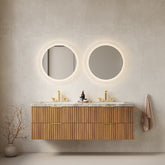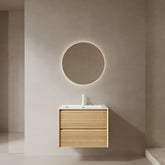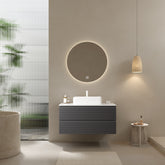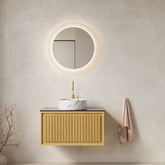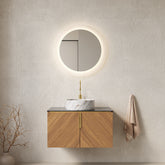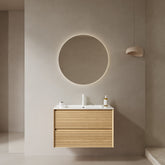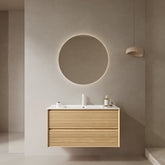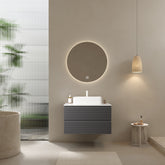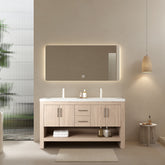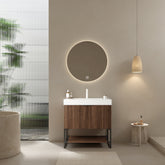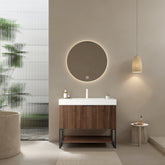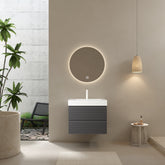Monochrome Bathroom Decor: Chic and Minimalist Ideas
Introduction
When I first considered redesigning my bathroom, I found myself drawn to the sleek and timeless appeal of monochrome decor. There’s something effortlessly elegant about a space dressed in black, white, and subtle shades of gray—it instantly creates a clean, modern atmosphere that feels both calming and chic.
As someone who values simplicity, I’ve always admired the principles of minimalist home styling: less clutter, more intention. That mindset guided every choice I made, from the tiles on the wall to the fixtures and accessories. The beauty of monochrome interior design is how well it blends form and function—no distractions, just pure sophistication.
What makes a minimalist bathroom so appealing is how it maximizes space and enhances light, making even smaller rooms feel more open. Whether you’re working with a compact layout or a spacious spa-inspired retreat, incorporating a black and white bathroom design offers a versatile foundation that can be styled to reflect your unique taste.
In this article, I’ll be sharing some of my favorite monochrome bathroom ideas — from sleek fixtures and neutral tone color schemes to clever ways to bring warmth and texture into a simplified design. Whether you’re planning a full renovation or just looking to refresh your space, I hope these tips inspire you to embrace the calm, chic vibe of monochrome minimalism.
1. Why Monochrome Works in Bathrooms
Creates a Sense of Space and Cleanliness
One of the main reasons I chose monochrome bathroom decor for my space is how instantly it makes everything feel more open and organized. A simple black and white bathroom design eliminates visual noise, which gives the room a clean, fresh feel. Especially in smaller bathrooms, this streamlined look can make a huge difference — it feels less crowded and more intentional.
Easy to Maintain and Style
Another reason I’m a big fan of monochrome interior design is the low-maintenance nature of it. Matching towels, choosing hardware, or updating small accessories becomes a breeze when everything falls under the same minimal color scheme. And the best part? It never feels outdated. A minimalist bathroom with a monochrome base gives me the flexibility to change things up seasonally without overhauling the whole look.
Timeless and Elegant Aesthetic
There’s something truly timeless about a well-designed monochrome space. Unlike bold colors that may fade in popularity, a neutral tone bathroom always looks polished and current. It’s a style that works across decades and trends. For me, this timeless elegance is what makes monochrome bathroom decor so rewarding — it's not just trendy, it's forever stylish.
2. Choosing the Right Monochrome Palette
When I first began exploring monochrome bathroom decor, I quickly realized it wasn’t just about black and white. There’s actually a wide spectrum of tones and shades that fall under the monochrome umbrella — and choosing the right combination can completely change the mood of the space. Here's how I approached it.
Classic Black and White
This was my starting point. A black and white bathroom design offers instant drama and sophistication. The contrast is bold yet refined, and when balanced correctly, it gives a space that luxurious, high-end feel without being over the top. I used white as the base color — for walls and larger surfaces — and brought in black through hardware, light fixtures, and framed mirrors for a clean, striking effect.
Shades of Gray
After exploring the classic route, I considered a softer look using varying shades of gray. Gray has this amazing ability to feel modern and calm at the same time. Whether you go with a light dove gray or a deep charcoal, it layers beautifully in a minimalist bathroom. I found that mixing textures — like matte tiles with glossy finishes — helped create visual interest without introducing new colors.
Earthy Neutrals and Taupes
If you want your monochrome interior design to feel warm and grounded, I highly recommend working with earthy tones like taupe, beige, or stone. These colors bring a soft, natural elegance to the bathroom, and they pair beautifully with wood or concrete finishes. For me, this palette felt more spa-like — cozy, calming, and a bit more organic than stark black and white.
Tips on Balancing Tones
One thing I learned the hard way: monochrome doesn’t mean monotonous. To avoid that cold, sterile look, I made sure to layer textures, mix matte and gloss surfaces, and play with patterns like herringbone or chevron. Even small touches — like a textured wall tile or a fabric shower curtain — helped add depth without breaking the minimalist styling. It’s all about creating harmony, not just sticking to one single shade.
3. Minimalist Fixtures and Fittings
Once I had the color palette locked in, the next step in my monochrome bathroom decor journey was choosing the right fixtures and fittings. For a true minimalist bathroom, every piece needs to serve a purpose while contributing to the clean, clutter-free aesthetic. Here’s how I approached it.
Sleek Wall-Mounted Vanities
I opted for a wall-mounted vanity to keep the floor space open and create a sense of lightness. These vanities not only look modern and elegant, but they also make cleaning so much easier. I went with a simple white finish with clean lines to complement my monochrome interior design, and it became an instant focal point in the room without being flashy.
Frameless or Black-Framed Mirrors
Mirrors are a big deal in bathroom design, and I knew I wanted something that felt both minimal and bold. I debated between frameless and black-framed styles — and ended up choosing a sleek black-framed mirror to add contrast and structure to the space. It played perfectly into my black and white bathroom design, offering just enough visual interest without overwhelming the clean look.
Floating Shelves and Hidden Storage Solutions
To stay true to my minimalist styling goals, I kept storage subtle and practical. Floating shelves in neutral tones offered space for decor and daily essentials, while hidden cabinets behind the vanity and mirror kept clutter out of sight. I found that keeping visible surfaces clean really enhanced the serene, streamlined vibe of the room.
Simple Matte Black or Chrome Faucets
When it came to hardware, I kept things understated but intentional. Matte black faucets added a sharp, modern touch to the space, echoing other black accents like my mirror frame and light fixtures. I also love the look of chrome for a more reflective, polished finish. Both options work beautifully in neutral tone bathroom designs, and choosing simple, geometric shapes kept everything feeling cohesive and modern.
4. Tile and Wall Design Ideas
One of the most exciting parts of designing my monochrome bathroom decor was getting creative with tiles and wall treatments. While a minimalist bathroom calls for simplicity, that doesn’t mean the walls have to be boring. With the right textures and patterns, I was able to bring depth and personality into the space without breaking away from the clean aesthetic. Here are some of the ideas I tried — and loved.
Subway Tiles with Black Grout
Subway tiles are a classic, but pairing them with black grout gave them a whole new attitude. The contrast created this crisp, graphic look that worked perfectly with my black and white bathroom design. It’s a small tweak that made a big impact — and best of all, black grout is much easier to maintain than white, which helped me keep that fresh, clean feel day after day.
Geometric Monochrome Tiles
To add a modern edge, I introduced some geometric monochrome tiles to the floor. These patterns brought visual interest and movement, especially in an otherwise neutral space. The key here was sticking to a limited color palette — mostly gray and white — so the pattern added personality without overwhelming the monochrome interior design theme.
Painted Walls vs. Textured Panels
When deciding between painted walls and textured finishes, I found that both had their merits. Painted walls in soft grays or warm taupes were easy to update and created a clean backdrop. But I also experimented with textured panels — like fluted or ribbed wall panels — which added a layer of depth and sophistication, especially around the vanity area. It’s amazing how much texture can elevate a neutral tone bathroom without adding any actual color.
Accent Walls in Darker Hues
To break up the lightness, I added an accent wall in a deep charcoal gray behind the mirror. It grounded the space and created contrast, which is essential in minimalist styling. If black feels too intense, darker hues like slate, espresso, or deep taupe also work beautifully to add richness while staying within the monochrome palette.
5. Accessorizing with Purpose
One of the things I’ve come to appreciate most about monochrome bathroom decor is that every item truly matters. In a space driven by simplicity and clarity, there’s no room for random or overly decorative pieces. That’s why I focused on accessorizing with purpose — choosing every item intentionally to elevate the minimalist bathroom aesthetic while maintaining a cohesive look. Here’s how I made the details work for me.
Using Textures for Visual Interest
Even within a tight monochrome interior design palette, I found that mixing textures could create richness and depth. I played with contrasts like matte vs. gloss finishes — for example, pairing matte black faucets with glossy ceramic tiles, or rough stone soap dishes with smooth countertop surfaces. These subtle shifts in texture kept the space from feeling flat or sterile, while still staying true to minimalist styling.
Matching Textiles: Towels, Rugs, and Shower Curtains
Accessories like towels and rugs are where I reinforced the color palette without adding clutter. I chose towels and bath mats in soft grays and off-whites, keeping everything within the same tonal range. A solid white shower curtain with a black trim echoed the rest of my black and white bathroom design, tying the space together. I kept patterns to a minimum and let quality fabrics and finishes speak for themselves.
Minimalist Lighting
Lighting played a huge role in achieving that clean, modern look I was going for. I selected minimalist lighting fixtures like sleek wall sconces and a single matte black pendant light over the vanity. To enhance the ambiance, I added hidden LED light strips under the mirror and floating shelves. These created a soft, warm glow — perfect for making the bathroom feel cozy and elevated at the same time.
For me, accessorizing in a monochrome space was about editing, not adding. It’s amazing how the right combination of textures, tones, and lighting can transform a neutral bathroom into a calm, beautifully curated sanctuary.
6. Bringing in Natural Elements
While I absolutely love the sleek, crisp lines of monochrome bathroom decor, I quickly realized that bringing in a few natural elements made the space feel more grounded and inviting. A minimalist bathroom doesn’t have to feel cold or overly sterile — and with just a few thoughtful additions, I was able to strike the perfect balance between simplicity and warmth. Here’s how I did it.
Pairing Monochrome with Wood or Stone
Incorporating raw materials like wood and stone added an organic contrast to my otherwise clean-lined space. A floating wood vanity in a warm oak tone softened the black and white elements, while a natural stone soap tray brought texture and an earthy vibe. These materials paired beautifully with my monochrome interior design and introduced a sense of calm that fit right in with my minimalist styling.
Minimalist Greenery
Adding greenery was another game-changer. I didn’t go overboard — instead, I kept it simple with a few small succulents on the windowsill and an air plant tucked on a floating shelf. These tiny pops of green broke up the neutral tones just enough to bring life to the room, without disrupting the clean, minimalist aesthetic. Plus, they’re super low-maintenance — which fits right in with the ease and simplicity I wanted from this space.
Natural Light as a Design Feature
Finally, I learned to treat natural light as a design element all its own. I kept the window treatments minimal to let the light flood in, and used sheer curtains to soften the glare. The way light bounced off the white tiles and matte surfaces added a subtle glow throughout the day — a reminder that even the simplest neutral tone bathroom design can feel dynamic and alive with the right lighting.
Bringing natural elements into my monochrome bathroom helped me elevate the space from stylish to serene. It’s the little touches — a wooden tray, a tiny succulent, a sunbeam on the wall — that remind me minimalism doesn’t mean missing out on warmth or personality.
7. Common Mistakes to Avoid
When I first started planning my monochrome bathroom decor, I thought it would be as simple as choosing black and white and calling it a day. But like any minimalist bathroom project, there are some common traps that can throw off the balance and turn chic into chaos. Here are a few lessons I learned the hard way — and what I’d recommend avoiding if you want your monochrome interior design to feel both stylish and livable.
Overdoing the Contrast
One of the first mistakes I made was going too heavy on the contrast — I had way too much black at one point, which made the room feel cramped and overwhelming. On the flip side, an all-white space can feel bland or even clinical. The trick is finding harmony between light and dark elements. By adding shades of gray, taupe, or natural wood, I was able to soften the transitions and make the room feel more cohesive and inviting.
Ignoring the Importance of Lighting
Lighting is everything in a neutral tone bathroom. At first, I didn’t pay enough attention to where the light would fall or how it would affect my color choices. Flat lighting made my monochrome palette look dull and lifeless. Once I introduced layered lighting — like LED strips, wall sconces, and pendant lights — the space instantly felt warmer and more dynamic. I also made sure to maximize natural light wherever possible.
Creating a Cold or Uninviting Atmosphere
Minimalism can easily go from elegant to empty if you’re not careful. I initially skipped textures and accents to stay “clean,” but the result was a bathroom that felt cold and unfinished. To fix that, I layered in subtle textures, warm materials like wood or stone, and even a bit of greenery. These small additions brought in comfort and personality without disrupting the minimalist vibe.
At the end of the day, monochrome styling is about balance — between light and dark, hard and soft, simple and expressive. Avoiding these common pitfalls helped me create a bathroom that feels timeless, thoughtful, and uniquely mine.
8. Real-Life Inspiration
When I was designing my own monochrome bathroom, I found so much inspiration by exploring real-life examples online. Seeing how others approached minimalist bathroom design — especially with different layouts, materials, and accents — helped me imagine what might work in my own space. Whether it was bold black and white bathrooms or subtle neutral tone bathroom designs, these visuals made all the difference in helping me refine my vision.
Instagram Finds
Instagram is a goldmine for monochrome interior design inspiration. I followed hashtags like #MonochromeBathroom, #MinimalistBathroom, and #ScandiBathroom to discover creators and designers who had mastered this look. Some accounts featured stunning black tiled showers with white vanities and matte black fixtures, while others leaned into warm gray tones and minimalist styling with floating shelves and stone sinks. It was amazing to see how versatile the monochrome aesthetic could be — from ultra-modern to more organic and serene.
Pinterest Mood Boards
On Pinterest, I created a mood board packed with bathroom spaces that used monochrome palettes in creative, balanced ways. I was drawn to ideas like geometric floor tiles in black and white, or soft gray wall paint paired with natural wood vanities and matte black hardware. Pinterest also helped me organize and compare different design ideas, making it easier to see what would align with my space and style.
Real Home Tours and Blogs
I also explored interior design blogs and YouTube home tours, where homeowners walked through their finished minimalist bathrooms and shared their process. Seeing real people talk about their material choices, layout decisions, and favorite features gave me a deeper appreciation for the details that go into a successful monochrome design.
At the end of the day, gathering real-life examples helped me build confidence and trust my instincts. Whether you’re looking for that perfect black faucet or wondering how to warm up an all-white space, there’s plenty of visual inspiration out there to guide your monochrome bathroom decor journey.
Conclusion
Designing my monochrome bathroom was one of the most rewarding home projects I've taken on. The blend of minimalist bathroom decor with a clean, balanced color palette created a space that feels both calming and effortlessly stylish. There's something undeniably chic and timeless about a well-executed monochrome interior design — it doesn’t try too hard, yet always looks pulled together.
If you're considering a similar transformation, my biggest piece of advice is: don’t be afraid to start small. You don’t need to overhaul your entire bathroom overnight. Try changing one key element first — maybe a sleek black vanity, a minimalist LED mirror, or a fresh set of monochrome tiles. From there, build around it, paying attention to texture, lighting, and balance. That’s exactly how I started, and it gave me the freedom to experiment without getting overwhelmed.
Whether you lean toward bold contrast or prefer softer neutral tones, the monochrome palette is endlessly versatile. And when paired with a minimalist mindset, it allows every element to shine. Trust me — once you find your rhythm, your bathroom won’t just be a functional space, it’ll be a design statement you’ll love walking into every day.
Featured Products
60" Bathroom Vanity with Sink, Wall-Mounted Bathroom Storage Cabinet with Drawers
- 2,075.00USD
- 2,075.00USD
- Unit price
- / per
30" Wall-Mounted Bathroom Vanity with Ceramic Sink
- 691.00USD
- 691.00USD
- Unit price
- / per
24" Wall-Mounted Bathroom Vanity with Ceramic Sink
- 566.00USD
- 566.00USD
- Unit price
- / per
36" Floating Bathroom Vanity with Vessel Sink
- 783.00USD
- 783.00USD
- Unit price
- / per
30" Wall-Mounted Bathroom Vanity with Sink
- 691.00USD
- 691.00USD
- Unit price
- / per
30" Modern Wall Mounted Bathroom Vanity with Sink
- 585.00USD
- 585.00USD
- Unit price
- / per
30" Floating Bathroom Vanity with Sink
- 628.00USD
- 628.00USD
- Unit price
- / per
36" Wall-Mounted Bathroom Vanity with Ceramic Sink
- 726.00USD
- 726.00USD
- Unit price
- / per
30" Bathroom Vanity with Vessel Sink, Gray Color
- 720.00USD
- 720.00USD
- Unit price
- / per
36" Modern Bathroom Vanity, Wall-Mounted, Natural Walnut Woodgrain Color
- 770.00USD
- 770.00USD
- Unit price
- / per
60" Bathroom Vanity with Sinks, Freestanding Oak Woodgrain Color
- 1,513.00USD
- 1,513.00USD
- Unit price
- / per
30" Freestanding Bathroom Vanity with Sink, Retro Walnut Woodgrain Color
- 865.00USD
- 865.00USD
- Unit price
- / per
36" Freestanding Bathroom Vanity with Sink, Retro Walnut Woodgrain Color
- 920.00USD
- 920.00USD
- Unit price
- / per
24" Bathroom Vanity with Undermount Sink, Gray Color
- 690.00USD
- 690.00USD
- Unit price
- / per
36" Wall-Mounted Bathroom Vanity with Ceramic Sink, Dark Oak Woodgrain Color
- 770.00USD
- 770.00USD
- Unit price
- / per



















